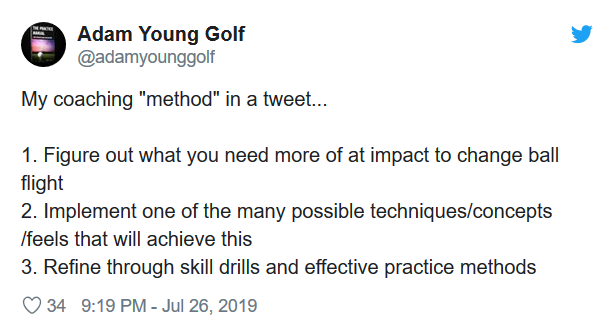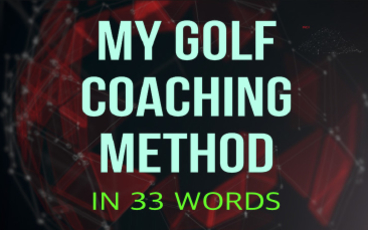The other day, I tried to condense my golf-coaching philosophy into Twitter’s 28-character limit.
While the tweet was just 33 words long, I’ll attempt to add a few more thoughts in this article to flesh it out a little more. If you would like a 110K word version, my best-seller, “The Practice Manual – The Ultimate Guide for Golfers”, is the more comprehensive version. CLICK HERE to check that out
I don’t have a golf swing model that I force everyone to adhere to. Why? Because;
- Having a model-like swing doesn’t guarantee anything – other than you’ve probably spent a lot of years making it look a certain way
- Plenty of tour players have non-model swings, including many of the game’s greatest (Arnold Palmer, Jack Nicklaus, Furyk… the list is endless)
- Many amateurs don’t have the time, inclination, physical ability to look like a tour pro – and they wouldn’t benefit as much (as they believe) from achieving “the look”
- I have a different coaching method that achieves results faster than “model-seeking” while, ironically, tending to improve swing mechanics and make swings look more model-like indirectly.
Note – this does not mean that I don’t change swing mechanics in my players. If you believe that, you are misunderstanding what I do as a coach. I simply don’t make all of my players look/move in the same way – towards some theoretical ideal.
So, if I am not working towards a model, what do I do?
My Golf Coaching “Method”
This tweet summarises my coaching method.

Let’s take a slightly more in-depth look.
1. Identify Impact Change
There is only one, universal goal of every instructional method out there – to improve how the club moves through the impact interval (the space where the clubhead is connected to the golf ball.
For this reason, the first thing I look at with a player is what they need to do more of at impact to improve their outcomes. The outcome and impact are 100% correlated.
The answer as to what needs to change at impact will (almost) always fall into one of the following – you will either need to change;
- Ground contact
- Face direction
- Face contact
- Club speed
- Swing path
- Angle of attack
- Dynamic loft
There are a few other (more advanced) things that we could be working on through impact (such as arc-shape), but even those things would be in an attempt to improve something in the above list.
As I’ve said many times before –
"If you’re not improving the impact interval, you’re not improving at all
That's a fact.
2. Implement Intervention
You’ve figured out what you need to change at impact to get your shots to fly like 2001 Tiger – what next?
Here’s where we implement an intervention that achieves a positive change at impact. Here’s the beauty
"There are many options we can use to change our impact”
Not only could we use a concept/feel/technique intervention, but even within those categories, we have many options.
For example, if we wanted to change the clubface direction through impact via a technical intervention, we could use
- A grip change
- A wrist angle change (flexion/extension)
- A set up change
- A forearm rotation change
To name a few!
Changing wrist angles/movements at certain points in the swing can affect clubface angle at impact
Are there better/worse options? Sure. Some changes have positive effects on several impact variables at once. Some changes will even make the swing look more neutral (compared to a model). Some changes will be easier to implement and have a greater chance of success. Some changes will even work towards improving consistency.
The problem many amateurs have is that the interventions they try to make in their own swings
- Have a low % chance of success
- Don’t fit their existing match ups (other swing pieces)
- Don’t relate to the impact variable they are trying to change
- At worst, can make the impact variable they are trying to change worse
3. Refine The Change
You’ve identified your desired impact change
You’ve implemented an appropriate intervention
Just like any medicine, you can take too much or too little. So, the next stage in the process is to calibrate.
This is usually a process of practice and repetitions with quality feedback, until you capture the “feel” for how much of a change gives you your desired results.
For example, you have decided to
- Change the clubface angle at impact via
- A change in wrist flexion at the top of your swing
Do #2 too little and you get your old pattern. Do it too much and you get the opposite pattern.
Finding the right amount is, therefore, a product of
- Hitting lots of shots
- Noticing the result
- Adjusting the change up/down in amount
When you have found the right amount, converting that mechanical focus into a feel that you can use on the course AND holding onto that feel for as long as possible.
In order to improve this phase of learning, I use a mix of practice methods that have been shown to increase the speed of learning, retention and transference to the course, including;
- Differential practice
- Variability practice
- Calibration training
- Game-simulation training
- Scaling
- Mixes of blocked/broken/random practice at varying times





